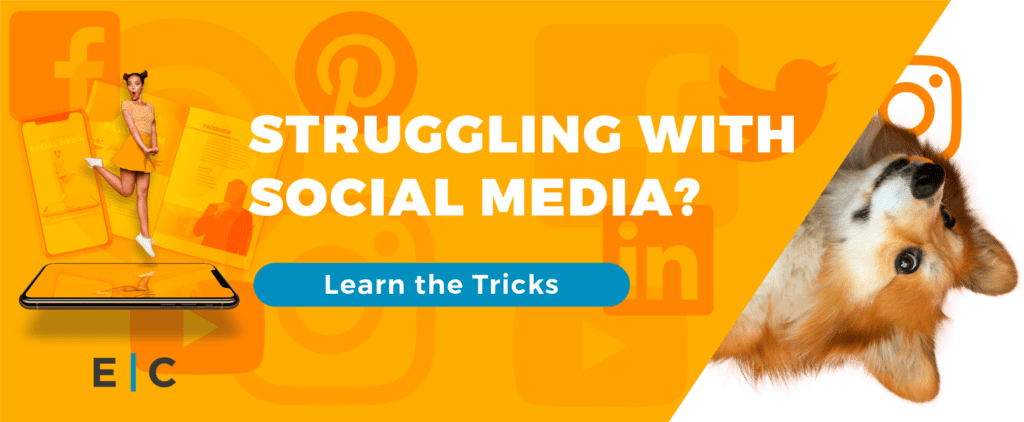How many times have you come up with social media questions without ever seeming to find satisfactory answers? If you’re trying to manage social media for your brand or employer, it can be frustrating. Fortunately, I’ve been there before and experience has taught me the answers to those questions.
Common Social Media Questions
In this post, I’m going to answer thirteen of the most commonly asked social media questions. If you have a question that doesn’t appear in this post, leave a comment with your query and I’ll be sure to add it to the list. Before you dive in further, I need to emphasize that successful social media management starts with a solid social strategy. If you haven’t developed a strategy yet, now is the time to get started.
1. How many social media accounts do I need for my business?
Some people will tell you that you need accounts on ALL the most popular social media platforms. Others will say you should only manage one social media platform. Here’s my answer:
The number of social media accounts you manage should not exceed the capacity of your workforce.
If you’re the only one managing social media for your brand, don’t try to spread yourself too thin by maintaining seven different accounts. Fewer accounts mean you’ll have more time to focus on quality.
On the other hand, if your staff is large enough—and has the required skills—you should be able to manage a larger number of social media accounts. Before you decide you need to manage twenty different platforms, though, continue on to question 5 to learn how to choose the best platforms.
2. What kind of content should I share?
While it can be difficult to create great content, the answer to this is simple.
Create content that does one—or more–of the following:
- Educates your audience
- How can you help them reach a goal? What are their biggest issues and frustrations?
- Inspires your audience
- What will elicit an emotional response? What resonates with them?
- Entertains your audience
- How can you shock or delight them? How can you capture their attention?
Build content for your audience and not for the brand–or brands–you manage.
3. How often do I need to post?
There are two answers to this:
- Post at times that offer low competition and high engagement opportunities
- Aim for these posting frequencies:
- 5-10 posts per week on Facebook
- 3-5 tweets per day on Twitter
- 1 or more posts per day on Instagram
- 5-30 posts per day on Pinterest
- 5-10 posts per week on LinkedIn
Posting frequency is not set in stone. You’ll need to experiment with different frequencies to see which ones stimulate account growth and audience engagement.
4. How much time does it take to maintain successful social media accounts?
This answer is a little vaguer; it depends.
Your level of success on social media will reflect the amount of time you invest. Keep in mind that managing social media involves much more than just posting status updates. It includes brainstorming new content and campaigns, creating content, engaging with the audience, and more.
On average, you should be checking your accounts daily to engage with your audience. The more engaged your audience is, the more time it will take each day.
Here’s my best answer; set aside a specific amount of time each day to manage your social accounts. If you find yourself running out of time, reevaluate the need to add more time each day. Base your decision on these two factors:
- Which tasks are generating the highest ROI and require more time?
- Are you managing your time wisely?
Strive to be as productive as possible during the specified time period. That will make it much easier to identify whether you need more time or need to remove low-performance tasks.
5. Which social networks are the best for small businesses?
This is the wrong question to ask. You only want to manage social accounts on platforms that your audience spends time on. YouTube might be one of the greatest social media platforms on the planet for many brands, but if your audience doesn’t use it then it’s not right for your business.
Find the platforms that provide the best opportunity to engage with your audience and stick with them.
6. If I can only manage one social media account, which platform should I choose?
This is a tricky question. The answer hinges on two things:
- Which platform best supports your goals
- Which platforms your audience lives on
It’s important to choose the platform that allows you to reach your audience and achieve your business goals at the same time. If your goal is to drive website traffic, you could justify using Facebook, LinkedIn, Twitter, or Pinterest. Then, the deciding factors should come down to which of the following are most important to your business:
- Which platform your audience prefers
- Which platform has the tools needed to target your audience
- Which platform has budget-friendly advertising options
- Which platform is geared toward your business model—B2B or B2C?
- Which platform is best equipped to drive revenue
7. How can I measure success on social media?
Set goals and track metrics. The answer isn’t always that simple, but in this case, the only way to know if you’re successful is to set expectations and measure whether you are meeting them or not.
Common metrics to track:
- Follower growth
- Referral traffic from social media
- Engagement rates
- Click rates
8. How can I find out which social channels my audience uses the most?
This requires multiple steps:
- Create buyer personas that outline who your ideal customers are
- Research demographic data to determine which platforms attract most of your buyer personas
- Conduct original research if you have the resources:
- Survey prospects, leads, and customers
- Interview people within your target audience
Pew Research Center, Statista, and Google search are your best friends when it comes to demographic research.
9. What is the one mistake I need to avoid at all costs?
Rushing. Never, ever rush. Mistakes are made when people rush. Take your time to analyze the potential outcomes before you post anything. It’s better to post great content a day or two late than to post crappy content on time.
10. What is the best way to attract followers on social media?
Be consistent. People like to follow accounts that share valuable content on a regular basis. It establishes trust by making your brand dependable. Focus on perfecting these three types of consistency:
- Posting frequency
- Content quality
- Brand voice
11. Do I need to use a content calendar?
You don’t have to, but it’s a good idea to use one. Content calendars organize your content in one place, allowing you to streamline your posting process and review content for errors before publishing. Aside from helping you identify areas of your content that are weak, it’s also a great way to build a consistent brand story.
12. Should I use a social media management tool?
This depends on how many brands you manage and how many social media accounts each brand has. You might manage one brand but they could have four active social accounts, or you could manage five brands that each have three active social accounts.
Social media management tools are incredibly helpful and can increase productivity while reducing the amount of time you spend posting. They may not be necessary for smaller businesses that only have two or three accounts, but brands that post content across six different social channels would benefit from managing all their accounts in one place.
Things to consider:
- Does your budget justify using a management tool?
- Do you need to free up time on social media for other important tasks?
If you answered “Yes” to either of these questions, you may want to consider using a social media management tool.
13. How can I make my social media accounts consistent?
Understand your brand’s identity inside and out. Everything from your cover photos and account names to your messaging and imagery tell a story about your brand.
Make your brand’s story consistent from beginning to end by double-checking the following areas:
- Account information–company descriptions, website URL, and profile handle
- Visual content–images, videos, and graphics
- Messaging–voice, tone, and copy
Remember, most of these answers are multi-dimensional depending on your circumstances. Social media isn’t an exact science. If you’re serious about creating a successful social media management process, you need to develop a strategy. If you’re looking for more information to assist your business during this time, head over to our Marketing Resources menu to gain access to our Lead Generation Calculator, Website Analyzer, and to Download our Free 2020 Social Media Guide!
-FINAL(01-00)-White&Blue-01.svg)





